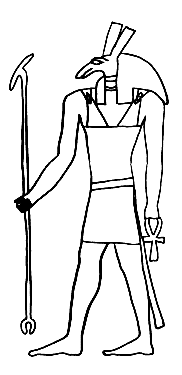
Der Gott des Chaos und der Verwirrung. Seth war ein Sohn von Geb und Nut und daher ein Bruder von Osiris, Isis und Nephthys; die letztgenannte Göttin war auch seine Gattin. Nach dem Tod des Osiris (der gemäß einigen Mythen von Seth ermordet worden war) kämpfte er lange Zeit mit Horus, dem Sohn des Osiris, um das Königtum. Der Kampf zwischen den beiden Gegnern war zeitweise sehr gewalttätig. So versuchte Horus, Seth mit einem Speer zu töten, als letzterer sich in ein Flußpferd verwandelte, und Seth riß dafür Horus ein Auge aus. Die Angelegenheit wurde schließlich im Göttlichen Tribunal beigelegt, das zugunsten des Horus entschied. Die ungeordnete Welt außerhalb des Niltales, die Wüste ebnso wie die Fremdländer, waren mit Seth verbunden. Daher wird der Gott manchmal mit fremden Göttinnen (Astarte, Anat) verbunden. Wie die meisten Götter hatte auch Seth eine andere, positive Seite. Er war es beispielsweise, der die böse Apophisschlange (Apep), den Erzfeind des Sonnengottes, allnächtlich erschlug. Seth wurde seit vorgeschichtlicher Zeit verehrt, was daraus hervorgeht, daß er auf allen Arten von Gegenständen aus dieser Zeit dargestellt ist. Dies war nicht nur in Naqada, wo er der Überlieferung zufolge geboren war, der Fall, sondern in ganz Ägypten. Jeder ägyptische König verkörperte sowohl Horus 'als auch' Seth, und sie wurden oft zusammen dargestellt, darunter auch an den Seiten einer Anzahl königlicher Throne in einer Szene, die die Vereinigung der Beiden Länder symbolisierte. Seth wurde in der 2. Zwischenzeit besondere Aufmerksamkeit und Ehre zuteil, als die Hyksos im Delta ihn verehrten (wahrscheinlich, weil sie ihn mit ihrem eigenen Gott Baal identifizierten), und auch in der Ramessidenzeit, als eine Anzahl von Königen nach ihm benannt wurde, zum Beispiel Sethos I. Seth wird gewöhnlich mit dem Körper eines Mannes und dem Kopf eines mythischen Tieres dargestellt, das manchmal einem Esel oder einem Ameisenbären gleicht. Es gibt auch verschiedene Tierdarstellungen des Gottes, der dann den Körper eines Raubtieres oder eines anderen Säugetieres besitzt, den Kopf des zuvor erwähnten mythischen Tieres und einen gegabelten, aufrechtstehenden Schwanz. Schließlich wird Seth auch in Gestalt verschiedener Tiere wie Flußpferd und Schwein gezeigt, die von den Menschen mit gemischten Gefühlen betrachtet wurden.